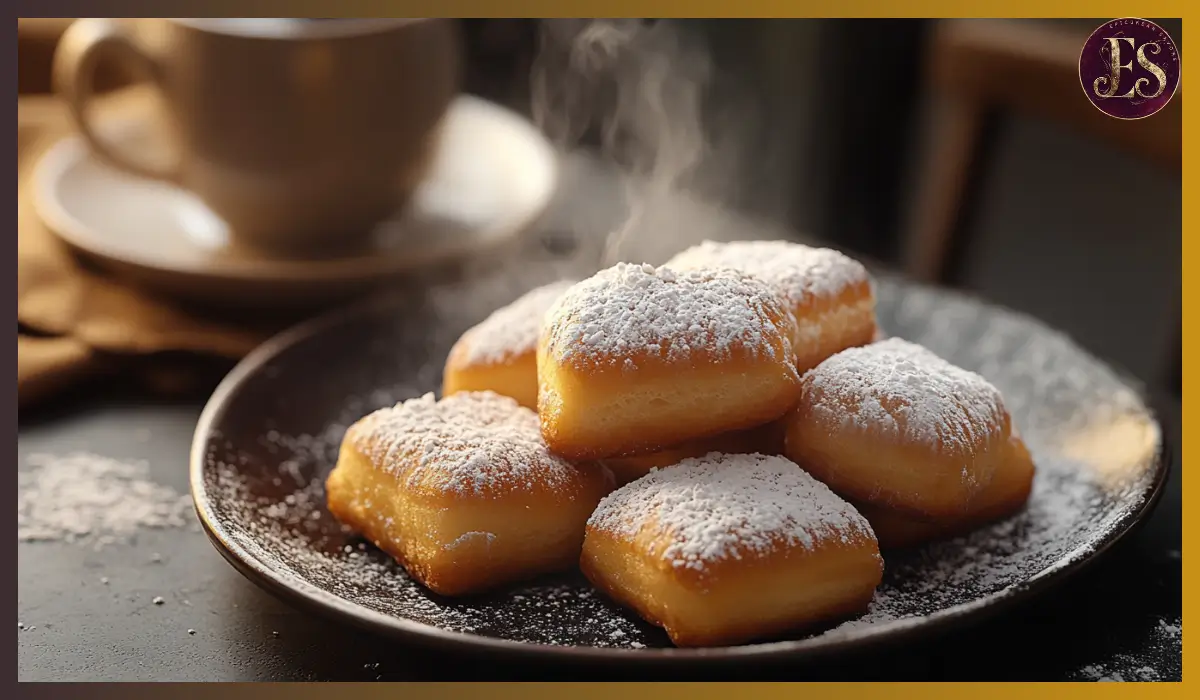There is something truly magical about a warm, freshly made Vanilla French beignet. Light, pillowy, and dusted with a generous snowfall of powdered sugar, these French-inspired pastries are the ultimate indulgence. Whether you’ve had them in a charming café in New Orleans or only seen them in movies, beignets are a treat worth mastering at home.
The beauty of Vanilla French beignets lies in their simplicity. They are made from a yeast-based dough, which is rolled out, cut into squares, and fried until golden brown. But what truly elevates this version is the infusion of vanilla. Using high-quality vanilla extract or fresh vanilla bean enhances the natural sweetness of the dough, making every bite even more irresistible.
One of the best parts about making beignets at home is that you get to enjoy them fresh. Unlike store-bought pastries, homemade beignets are at their peak the moment they come out of the fryer—crispy on the outside, soft and airy inside. And while they may seem intimidating, don’t worry! This recipe is straightforward and beginner-friendly, with plenty of tips to help you get that perfect texture.
Vanilla French Beignets are not just a breakfast treat; they’re also perfect for dessert or an afternoon snack with coffee. Serve them warm with a dusting of powdered sugar, and if you want to take things to the next level, dip them in chocolate or caramel sauce. Whether you’re making them for a cozy morning at home or a special occasion, these vanilla French beignets will make any moment feel extra special.
Why You’ll Love This Recipe
There are countless reasons to fall in love with homemade vanilla French beignets. First and foremost, they are incredibly light and airy. Thanks to the yeast-based dough, these pastries puff up beautifully when fried, creating that signature soft and fluffy texture. The crispy golden-brown exterior adds the perfect contrast, making each bite irresistible.
Another reason this recipe stands out is the rich vanilla flavor. Unlike traditional beignets, which are often plain, these are infused with vanilla extract or real vanilla bean, giving them an extra layer of warmth and sweetness. It’s a subtle but powerful enhancement that makes them even more addictive.
These Vanilla French beignets are also wonderfully versatile. While they are a fantastic breakfast treat, they can easily double as a dessert. Serve them with a drizzle of honey, a scoop of ice cream, or a side of fresh berries, and you have a show-stopping sweet treat for any time of day.
Beyond their taste, beignets are just plain fun to make. There’s something deeply satisfying about rolling out the dough, cutting it into perfect squares, and watching them puff up in the hot oil. It’s a hands-on cooking experience that feels rewarding, especially when you get to enjoy the fruits of your labor immediately afterward.
Most importantly, this recipe is approachable for all skill levels. Whether you’re a seasoned baker or a total beginner, I’ll walk you through each step to ensure your beignets turn out beautifully. With a few simple ingredients and a bit of patience, you’ll have a batch of homemade beignets that rival those from any café.
Health Benefits
While Vanilla French beignets are undoubtedly a treat, there are a few ways to make them slightly healthier without sacrificing flavor.
First, because beignets are homemade, you control the ingredients. Unlike store-bought pastries that often contain preservatives, artificial flavors, and excessive sugar, these are made with simple, natural ingredients. You can also adjust the sweetness to your preference, reducing the amount of sugar in the dough if desired.
Another benefit of homemade beignets is the use of fresh oil for frying. Many commercially fried foods are cooked in oil that has been reused multiple times, leading to the formation of harmful compounds. When you make beignets at home, you can ensure the oil is fresh and at the right temperature, resulting in a cleaner and lighter pastry.
If you want to add some nutritional value, consider incorporating whole wheat flour into the dough. While it will slightly change the texture, it adds fiber and nutrients. Additionally, pairing beignets with fresh fruit, such as berries or bananas, can balance out the meal with natural vitamins and antioxidants.
Finally, moderation is key. While beignets are fried, they don’t have to be an everyday indulgence. Enjoying them as an occasional treat, especially when made at home with wholesome ingredients, allows you to savor the experience without guilt.
Preparation Time, Servings, and Nutritional Information
- Preparation Time: 2 hours (including dough rising time)
- Cooking Time: 15 minutes
- Total Time: 2 hours 15 minutes
- Servings: Makes about 20 beignets
Estimated Nutrition Per Beignet:
- Calories: 180
- Fat: 7g
- Carbohydrates: 25g
- Protein: 3g
- Sugar: 8g
- Fiber: 1g
Ingredients List
For the Dough:
- 3 ½ cups all-purpose flour
- 2 ¼ teaspoons active dry yeast (1 packet)
- ¼ cup granulated sugar
- ½ teaspoon salt
- ¾ cup warm milk (about 110°F)
- 1 large egg
- 3 tablespoons unsalted butter, melted
- 1 tablespoon vanilla extract (or seeds from 1 vanilla bean)
For Frying & Topping:
- Vegetable oil, for frying
- 1 cup powdered sugar, for dusting
Step-By-Step Cooking Instructions
Activate the Yeast
In a small bowl, combine the warm milk, sugar, and yeast. Stir gently and let it sit for about 5-10 minutes until the mixture becomes foamy. This indicates that the yeast is active and ready to use.
Mix the Dough
In a large mixing bowl, whisk together the flour and salt. Make a well in the center and pour in the yeast mixture, melted butter, vanilla extract, and beaten egg. Stir until the dough starts to come together.
Knead the Dough
Transfer the dough to a lightly floured surface and knead for about 8-10 minutes until it becomes smooth and elastic. If the dough is too sticky, add a little more flour, one tablespoon at a time.
First Rise
Place the dough in a greased bowl, cover it with a clean kitchen towel, and let it rise in a warm place for about 1.5 hours, or until it doubles in size.
Roll & Cut the Dough
Once the dough has risen, punch it down to release any air bubbles. Roll it out on a lightly floured surface to about ¼-inch thickness. Use a sharp knife or pizza cutter to cut it into 2×2-inch squares.
Heat the Oil
In a deep saucepan, heat about 2 inches of vegetable oil to 360°F (use a thermometer for accuracy).
Fry the Beignets
Carefully place a few dough squares into the hot oil, frying them in batches. Cook for about 1-2 minutes on each side, until golden brown and puffy. Use a slotted spoon to transfer them to a paper towel-lined plate.
Dust with Sugar & Serve
While still warm, generously dust the beignets with powdered sugar. Serve immediately and enjoy!
How to Serve
Beignets are best served hot and fresh. Classic pairings include a cup of café au lait or a rich hot chocolate. For a fun twist, serve them with dipping sauces like chocolate ganache, caramel, or raspberry compote.
Pairing Suggestions
Pair your beignets with fresh fruit, such as sliced strawberries, to balance the sweetness. They also go well with a scoop of vanilla ice cream for a decadent dessert.
Storage, Freezing & Reheating Instructions
Store leftover beignets in an airtight container at room temperature for up to two days. To reheat, warm them in an oven at 350°F for 5 minutes. Avoid microwaving, as it can make them rubbery. Beignets can also be frozen for up to three months—just reheat them in the oven when ready to serve.
History and Cultural Significance of Beignets
Vanilla French Beignets have a rich history that dates back centuries. Originally from France, these delightful pastries were brought to Louisiana by French settlers in the 18th century. Over time, they became deeply rooted in New Orleans’ culinary culture, particularly within Creole and Cajun traditions. The most famous place to enjoy them is Café du Monde, where they are served hot and dusted with powdered sugar, often accompanied by a café au lait.
In France, beignets have many regional variations, from fruit-filled beignets to those made with choux pastry. However, New Orleans-style beignets are unique in their square shape and soft, pillowy texture. They are especially popular during Mardi Gras celebrations, symbolizing indulgence before Lent begins.
Beignets are more than just a treat; they represent a connection to history, culture, and community. Whether enjoyed at a bustling café or made fresh at home, they bring people together and offer a taste of tradition with every bite.
Best Ingredients to Use for the Perfect Beignet
The quality of ingredients can make or break your homemade Vanilla French beignets. Starting with the right flour is key—use all-purpose flour for the perfect balance of softness and structure. A high-quality vanilla extract or fresh vanilla bean will enhance the flavor, giving your beignets a deeper, more aromatic sweetness.
For the yeast, always check the expiration date to ensure it’s active. Fresh yeast will help the dough rise properly, creating that signature airy texture. Using warm milk instead of water adds richness to the dough, while melted butter provides extra flavor and tenderness.
When it comes to frying, opt for a neutral oil like vegetable or canola oil. These oils have a high smoke point and won’t overpower the delicate vanilla flavor. Finally, don’t skimp on the powdered sugar—sifting it before dusting ensures an even, clump-free coating that melts beautifully into the warm pastry.
How to Get the Perfect Fry Every Time
Frying beignets may seem intimidating, but with a few simple techniques, you can achieve bakery-quality results at home. The most crucial factor is maintaining the right oil temperature—360°F is ideal. If the oil is too hot, the outside will brown too quickly while the inside remains doughy. If it’s too cool, the beignets will absorb excess oil, becoming greasy and heavy.
Using a thermometer is the best way to ensure consistent results. If you don’t have one, test the oil by dropping in a small piece of dough—it should sizzle and float to the surface within a few seconds.
Frying in small batches prevents overcrowding, allowing each beignet to cook evenly. Flipping them once halfway through ensures both sides become perfectly golden. After frying, place them on a paper towel-lined plate to absorb any excess oil. For an extra crisp exterior, let them rest for a minute before dusting with powdered sugar.
How to Make Beignets Without Deep Frying
If you love beignets but prefer to avoid deep frying, there are alternative methods that still produce delicious results. One option is to bake them in the oven. Arrange the dough squares on a parchment-lined baking sheet and bake at 375°F for about 10 minutes, or until puffed and golden brown. While they won’t have the same crisp exterior as fried beignets, they’ll still be soft, airy, and delicious.
Another alternative is air frying. Preheat your air fryer to 350°F and lightly spray the dough squares with oil. Air fry for about 5-6 minutes, flipping halfway through, until golden. This method provides a texture closer to deep frying, but with significantly less oil.
For those looking to reduce oil but still get a crispier finish, try pan-frying. Heat a small amount of oil in a nonstick pan and cook each beignet until golden brown on both sides. No matter which method you choose, dusting with powdered sugar is essential for that classic beignet experience.
Frequently Asked Questions (FAQs)
Can I make the beignet dough ahead of time?
Yes! You can prepare the dough and let it rise overnight in the refrigerator. Just bring it to room temperature before rolling and frying.
Why didn’t my beignets puff up?
This could be due to expired yeast, incorrect oil temperature, or over-kneading the dough. Make sure your yeast is fresh and that the oil is at 360°F before frying.
Can I use a different type of flour?
All-purpose flour works best, but you can use a mix of all-purpose and whole wheat for a heartier texture. Gluten-free flour blends can also be used, but results may vary.
What’s the best way to reheat leftover beignets?
For the best texture, reheat in an oven at 350°F for 5 minutes. Avoid microwaving, as it can make them rubbery.
Can I freeze beignets?
Yes! Freeze them in a single layer on a baking sheet before transferring to a freezer bag. Reheat in the oven before serving.
What oil is best for frying beignets?
Neutral oils like vegetable, canola, or peanut oil work best. They have a high smoke point and won’t interfere with the flavor.
Can I use baking powder instead of yeast?
You can make a quick version using baking powder, but they won’t have the same airy, pillowy texture as yeast-based beignets.
How do I prevent my beignets from absorbing too much oil?
Make sure the oil is at the correct temperature and avoid overcrowding the pan. Drain them on paper towels immediately after frying.
Conclusion & Call to Action
Now that you have this foolproof recipe, it’s time to bring the magic of homemade beignets into your kitchen. Give it a try, and let me know how they turn out. If you loved them, share this recipe with friends and family! Happy baking!
Print
Vanilla French Beignets
- Total Time: 2 hours 15 minutes
- Yield: 20 beignets 1x
- Diet: Vegetarian
Description
These homemade Vanilla French Beignets are light, airy, and perfectly golden brown. Infused with rich vanilla flavor, they are best served warm with a generous dusting of powdered sugar. Enjoy them for breakfast, dessert, or an afternoon treat with coffee.
Ingredients
- 3 ½ cups all-purpose flour
- 2 ¼ teaspoons active dry yeast (1 packet)
- ¼ cup granulated sugar
- ½ teaspoon salt
- ¾ cup warm milk (110°F)
- 1 large egg
- 3 tablespoons unsalted butter, melted
- 1 tablespoon vanilla extract (or seeds from 1 vanilla bean)
- Vegetable oil, for frying
- 1 cup powdered sugar, for dusting
Instructions
- In a bowl, mix warm milk, sugar, and yeast. Let sit for 5-10 minutes until foamy.
- In a large bowl, combine flour and salt. Add the yeast mixture, melted butter, vanilla, and egg. Mix until a dough forms.
- Knead the dough for 8-10 minutes until smooth and elastic.
- Place the dough in a greased bowl, cover, and let rise for 1.5 hours until doubled in size.
- Roll out the dough to ¼-inch thickness and cut into 2×2-inch squares.
- Heat oil to 360°F in a deep saucepan. Fry the dough squares in batches, 1-2 minutes per side, until golden brown.
- Remove from oil, drain on paper towels, and dust generously with powdered sugar.
- Serve warm and enjoy!
Notes
- Best eaten fresh but can be stored in an airtight container for up to 2 days.
- To reheat, warm in an oven at 350°F for 5 minutes.
- Freeze for up to 3 months; reheat in the oven before serving.
- Prep Time: 2 hours
- Cook Time: 15 minutes
- Category: Breakfast, Dessert
- Method: Frying
- Cuisine: French, New Orleans-Inspired


